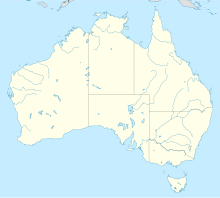This article includes a list of general references, but it lacks sufficient corresponding inline citations. (November 2024) |
 Processing plant of the Beverley Uranium Mine | |
| Location | |
|---|---|
| Location | Wooltana, South Australia[1] |
| State | South Australia |
| Country | Australia |
| Coordinates | 30°11′34″S 139°35′51″E / 30.192876°S 139.597637°E |
| Production | |
| Products | Uranium |
| History | |
| Opened | 2001 |
| Owner | |
| Company | Heathgate Resources Pty. Ltd. |
| Website | www.heathgateresources.com.au |
The Beverley Mine is Australia's third uranium mine and Australia's first operating in-situ recovery mine. It is located in South Australia in the gazetted locality of Wooltana about 35 km from Lake Frome at the northern end of the Flinders Ranges.[1] It officially opened in 2001.[2] The original Beverley uranium deposit was discovered by one of Bill Siller's companies in 1969 and was named after his wife—Beverley Siller.
The mine is owned and operated by Adelaide-based company Heathgate Resources Pty Ltd. Heathgate Resources is a wholly owned subsidiary of General Atomics.[3][4]
Beverley is a palaeochannel uranium deposit. The uranium mineralisation (mainly coffinite) is hosted by loose sands in the channel of a former river. The ore bearing horizon is now at a depth of about 100 to 150m. The deposit is estimated to contain 21,000 tonnes of uranium oxide for a mine life of 15 to 30 years.[2] Uranium is extracted by in-situ leaching, involving the injection of a fluid containing sulphuric acid and hydrogen peroxide into the ore-bearing permeable horizon to mobilise the uranium. The fluid is then recovered and uranium is extracted at a central plant using ion-exchange. The final concentrate is trucked to Port Adelaide and then shipped to international customers.
In August 2008, Federal approval was given to Heathgate for a greater area to be accessed for mining in order for the pre-approved volume of material to be extracted from the mine.[5]
Between 1998 and 2007, Heathgate reported 57 spill incidents to Department of Primary Industries and Regions South Australia (PIRSA).[6][7]
- ^ a b "Search result for "Beverley Uranium Mine" with the following datasets selected - "Suburbs and Localities", "SA Government Regions" and "Gazetteer"". Location SA Map Viewer. Government of South Australia. Retrieved 29 July 2019.
- ^ a b "FAQ's:The Mine". Heathgate Resources. Archived from the original on 2009-09-13. Retrieved 2009-07-16.
- ^ "Affiliated Companies". Retrieved 2016-09-19.
- ^ "Heathgate Resources". www.heathgate.com.au. Retrieved 2016-09-19.
- ^ Sabra Lane (2008-08-28). "Garrett approves Beverley uranium mine expansion" (Transcript). PM on ABC Local Radio. Australian Broadcasting Corporation. Retrieved 2009-07-16.
- ^ Beverley Uranium Mine Spill Incident summary as reported by Heathgate Resources 1998-2003 Archived 2011-03-02 at the Wayback Machine, pir.sa.gov.au
- ^ Beverley Uranium Mine Spill Incident summary as reported by Heathgate Resources 2004-2007 Archived 2011-06-15 at the Wayback Machine, pir.sa.gov.au
